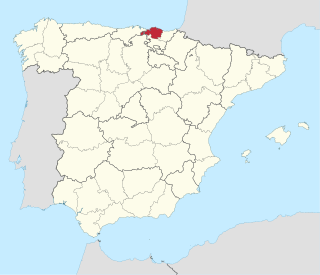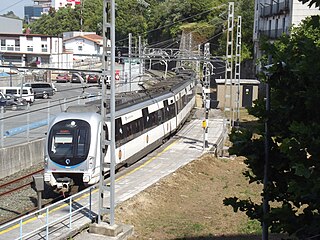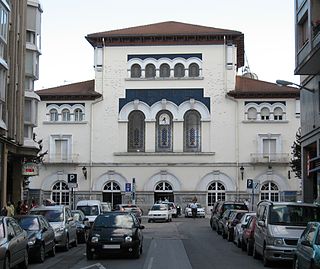
Basque Y is the high-speed rail network being built between the three cities of the Basque Autonomous Community, in Spain; Bilbao, Vitoria-Gasteiz and Donostia-San Sebastián. [1]

Basque Y is the high-speed rail network being built between the three cities of the Basque Autonomous Community, in Spain; Bilbao, Vitoria-Gasteiz and Donostia-San Sebastián. [1]



It will transport cargo and passengers. The cargo trains will connect the Port of Bilbao with the Port of Pasaia, (also known as Pasajes/Pasajes-San Pedro). The new high-speed network will consist of 172 km long track. [1] Due to the mountainous relief of the region, 104,3 km (61%) will be in 80 tunnels and 17 km (10%) in 71 bridges, leaving only 50.6 km, 29% of the route on the ground, in trenches or embankments.
The maximum speed is 120 km/h for freight trains, whilst passenger trains will travel at speeds of 220 km/h to 240 km/h.
The Basque Y will be built in European rail gauge (1,435 mm (4 ft 8+1⁄2 in) ). It will connect Madrid via Valladolid and connect France via Irun. While the French high-speed rail line (on which the TGV trains achieve their top speeds) is not planned to reach Hendaye until 2032, the Hendaye-Bordeaux track allows 160 km/h. The network will also include a connection to the Navarrese Corridor, the high speed line projected between Zaragoza and the capital of Navarre, Pamplona. [2]
As announced initially, it could take well under one hour to connect the cities while the current slower network takes from 1 h 40 min to 2.5 hours. However, a closer study revealed in February 2015 that the projections below do not possibly hold water, conspicuously delaying initial time estimates. [3]
| Origin | Destination | Straight line distance | Current minimum travel time by train | By bus | By car | Projected time on the Basque Y |
|---|---|---|---|---|---|---|
| Bilbao | Donostia-San Sebastián | 78 km | 2 h 13 min | 1 h 10 min | 1 h | 38 min |
| Bilbao | Vitoria-Gasteiz | 50 km | 2 h 20 min | 1 h | 45 min | 28 min |
| Vitoria-Gasteiz | San Sebastián | 76 km | 1 h 40 min | 1 h 30 min | 1 h 10 min | 34 min |
| Bilbao | Madrid | 321 km | 4 h 50 min | 4 h 45 min | 4 h | 2 h 15 min |
It took 19 years from the first proposals of a Basque high-speed network to the detailed project. The main issues were disagreements between the series of Spanish and Basque governments, and who would bear the costs. Through the Basque tax agreement, the Spanish government will make initial payments on behalf of the Basque government. [1]
An agreement on 24 April 2006 put the section between Vitoria-Gasteiz and Bilbao under Spanish control (through Adif), and the section in Gipuzkoa province under Basque control. [5] It will be the costliest investment in the Basque Country. The completion of the works was originally forecast for 2017, [1] but it's been delayed several times since then.
In June 2012, the European Investment Bank agreed to offer €1bn of funding. [1]
In early 2015, relevant public authorities (Basque Government, Spanish Ministry of Public Works) renewed their commitment with the project, while on the French branch (Aquitaine) financial tensions and public interest considerations risk to halt progress in high-speed rail works.[ clarification needed ] In May 2017 a new collaboration agreement was signed between the Basque Government and the Spanish Ministry making changes in the previous agreement from 2006. In October 2017 the deadline was set in year 2023 by Basque high-ranking officials. [6] However, in end 2022 Adif's draft budget put the completion of the Basque Y to the year 2027. A connection with Pamplona via two different alternative routes, one via Vitoria-Gasteiz and one via Ezkio/Itsaso is currently in debate.
As of February 2024 [update] services are planned to begin in 2027. [4]
It will ease mobility between the Basque capitals, in fact, travel times between Bilbao, Donostia-San Sebastián and Vitoria-Gasteiz will be cut in half.[ clarification needed ] In addition, the Basque government is improving the existing EuskoTren infrastructure between Bilbao and Donostia-San Sebastián, enabling a better connection between smaller towns and big cities.
The cargo traffic will ease congestion due to road traffic, reduce probability of accidents and help in territorial integration. The railway will connect the Port of Bilbao with Europe's major railway lines. [1] The Basque Y is being built in European rail gauge (1,435 mm (4 ft 8+1⁄2 in)).
To reduce the environmental impact, the layout avoids the natural areas of Aizkorri, Urkiola and Aralar. The increase on the usage of railway, will reduce the usage of planes,[ citation needed ] more polluting than trains. In addition it will be more affordable than traveling by plane, and taking passengers to the very centre of cities, instead of the outskirts, where airports are usually located.
The official Y-shaped layout was approved by the Basque Parliament, but criticised by Ezker Batua-Berdeak, a coalition of the Basque branch of United Left, a component member of the Basque Government in 2007. EB put forward a U-shaped layout. [7] [8]
More significant is the opposition staged by the Basque nationalist left and several ecologist groups, such as AHT Gelditu. A demonstration against the train gathered thousands to Arrasate/Mondragón in December 2007. Before the 2010-2011 permanent ceasefire, the Basque armed separatist group ETA had the works as one of its targets. [9] In December 2008, Ignacio Uría Mendizábal, the chief executive of a construction company working on the project, was shot dead by ETA [10] [11] and in February 2009 a bomb planted against Ferrovial went off in Madrid.
PNV's Basque Government has voiced its concern and mistrust over the Madrid government's actual commitment in the face of overdue funding by December 2014. [12] EH Bildu, the leading political force in Gipuzkoa, confirmed in early 2015 its frontal refusal to the project, pointing to the Basque Y's alleged shaky foundations (financially no return or loss, feeble public service). Basque nationalist left's spokespersons labelled the project a "deception-based propaganda operation". [13]

Biscay or Bizkaia, is a province of the Basque Autonomous Community, heir of the ancient Lordship of Biscay, lying on the south shore of the eponymous bay. The capital and largest city is Bilbao.

Rail transport in Spain operates on four rail gauges and services are operated by a variety of private and public operators. Total railway length in 2020 was 15,489 km. The Spanish high-speed rail network is the longest HSR network in Europe with 3,966 km and the second longest in the world, after China's.

Euskotren Trena, formerly known just as Euskotren is a commuter, inter-city and urban transit train-operating company that operates local and inter-city passenger services in the provinces of Biscay and Gipuzkoa, in the Basque Country, Spain. It is one of the four commercial brands under which Euskotren operates, as a public company managed by the Basque government. The entire 181.1-kilometre (112.5 mi) network uses 1,000 mm narrow gauge rail tracks which have been owned by the Basque Government since their transferral from the Spanish government; the rail tracks and stations were part of the FEVE network until its transferral. Euskotren Trena also operates the Donostia/San Sebastián metro under the brand Metro Donostialdea.

Euskotren Tranbia is the brand under which the tramway networks in the cities of Vitoria-Gasteiz and Bilbao are run. The system in Bilbao started operations in 2002, and the one in Vitoria-Gasteiz in 2008. It is one of the four commercial divisions under which Euskotren operates. The infrastructure is owned by the public entity Euskal Trenbide Sarea and tracks use 1,000 mm narrow gauge.

The Basque Country is the name given to the home of the Basque people. The Basque Country is located in the western Pyrenees, straddling the border between France and Spain on the coast of the Bay of Biscay.

Eibar is a city and municipality within the province of Gipuzkoa, in the Autonomous Community of Euskadi. It is the capital of the eskualde / comarca of Debabarrena.

Gipuzkoa is a province of Spain and a historical territory of the autonomous community of the Basque Country. Its capital city is Donostia-San Sebastián. Gipuzkoa shares borders with the French department of Pyrénées-Atlantiques at the northeast, with the province and autonomous community of Navarre at east, Biscay at west, Álava at southwest and the Bay of Biscay to its north. It is located at the easternmost extreme of the Cantabric Sea, in the Bay of Biscay. It has 66 kilometres of coast land.

Ezkio-Itsaso is a municipality in the province of Gipuzkoa, in the autonomous community of Basque Country, in northern Spain.

Lazkao is a town and municipality located in the Goierri region of the province of Gipuzkoa, in the Basque Country.

Atxondo is a municipality located in the province of Biscay, in the Basque Country, Spain. Atxondo is part of the comarca of Durangaldea and has a population of 1,447 inhabitants as of 2007 according to the Spanish National Statistics Institute.

The University of the Basque Country is a Spanish public university of the Basque Autonomous Community.

San Sebastián, officially known by the bilingual name Donostia / San Sebastián, is a city and municipality located in the Basque Autonomous Community, Spain. It lies on the coast of the Bay of Biscay, 20 km from the France–Spain border. The capital city of the province of Gipuzkoa, the municipality's population is 188,102 as of 2021, with its metropolitan area reaching 436,500 in 2010. Locals call themselves donostiarra (singular), both in Basque and Spanish. It is also a part of Basque Eurocity Bayonne-San Sebastián.

The Basque Autonomous Community [ A.C.], also officially called Euskadi [], is an autonomous community in northern Spain. It includes the Basque provinces of Araba, Bizkaia, and Gipuzkoa. It also surrounds an enclave called Treviño.
Euskotren, formally known as Basque Railways, is a public railway company controlled by the Basque Government and officially established in 1982 to operate several 1,000 mm narrow gauge railways inside the autonomous community of the Basque Country, under the terms of the Statute of Autonomy of the Basque Country. Originally operating under the commercial brand ET/FV, it took control of the management and operations of the narrow gauge lines formerly operated by the railway company FEVE. The commercial brand eventually changed to Euskotren, as it remains today. Since 2006, the infrastructure on which the company runs its trains has been owned by Euskal Trenbide Sarea.
Tourism in the Basque Autonomous Community has increased considerably in recent years, and is a popular destination for tourists from Spain and France. According to data from the Eustat the number of tourists entering the region in the year 2009 was 1,991,790, with the final result still pending. 71% of the yearly visitors come from the rest of Spain; the greatest number from Madrid Autonomous Community (14.2%), and Catalonia (11.1%). International visitors make up the remaining 29% - the largest percent come from France (7.2%). 62% of the people who come to the Basque Autonomous Community visit one of the three capitals, 27% visit inland and 11% visit the coast. The average stay of the visitors is 2 days.

Euskotren operates frequent commuter rail services in the city of San Sebastián and the surrounding Donostialdea area, in the Basque Country, Spain. The infrastructure is gradually being upgraded to rapid transit standards, in order to create the San Sebastián Metro. The line is commonly known as Topo, due to the large number of tunnels present. As of 2021, the San Sebastián suburban rail services are branded as part of the Euskotren Trena network, with no separate identity.

Oskar Matute García de Jalón is a Basque politician and a member of the Congress of Deputies of Spain. He was previously a member of the Basque Parliament.

Vitoria-Gasteiz railway station is the main railway station in the Basque capital city of Vitoria-Gasteiz in Spain.

San Sebastián railway station, also known as Donostia-San Sebastián or Estación del Norte is the main railway station of the Spanish city of San Sebastián, Basque Country. It served over 2 million passengers in 2018.
Euskotren is a public railway operator in the Basque Country, Spain. Its rolling stock is formed by electrical multiple units used for Euskotren Trena commuter rail services, trams running on the Bilbao and Vitoria-Gasteiz tramway networks, and locomotives for hauling freight trains.